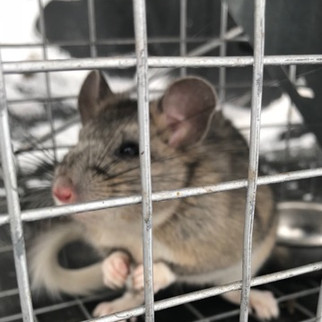Pack Rats...People think they're cute? I don't get it!
- Launa Benson
- Nov 6, 2017
- 3 min read
Pack rats, which are also referred to as wood rats pick up any curious object they find in their habitat and “pack” it to their den. Pieces of rock or wood, bones, hardware and other peculiar objects add strength to their home. If a pack rat is packing something to their den and find something else they want on their way, they will often drop what they are carrying and trade it for the new item. They are very fond of shiny objects.
These critters are rat-sized mammals with large ears, long tail and large dark eyes. The head and body length is about 7-8 inches with another inch or so for the tail. Their bodies are brown, cinnamon, or gray and their feet and belies are generally much lighter. Pack rats can climb and are usually active at night. Their dens are usually located on the ground ad measure 3-5 feet in height and diameter. One rat may inhabit several different nests and in good feeding areas a den may be occupied for years. They live alone except when mating or raising their young.
When there is a pack rat in your home, they are usually active at night when they are searching for food or nest materials. They are constantly looking for materials for their nest. They like to pack away small objects such as jewelry, utensils and other items. Pack rats can cause extensive damage to your property. Not only do they destroy landscaping but they can chew through wiring and spoil food. They have been known to shred upholstered furniture and mattresses. They also like to take up residence in parked vehicles, gnawing on wires, mechanical components and seats. One of our clients had a pack rat in her car that caused terrible damage to the inside of her car.
Pack rats diet consists of a variety of grass, leaves, fruit, nuts, bulbs, bark, seeds and they are also attracted to human food supplies. When you have a pack rat nesting in your building they may utilize available food within the structure but most often continue to feed outside.
If you see gnawing on wood, fecal pellets, hear noises (they can be quite vocal) or have a smell you can’t quite figure out the culprit could be a pack rat. Checking your vehicle periodically is important to prevent pack rat damage. The most effective pack rat control begins with prevention. Trash should be disposed of and sanitary conditions maintained.
When customers call us about pack rat situations, we immediately inspect their home for entry points. Since pack rats are very good climbers, it is important that we check any openings (high and low) into the home and also look for places where they have gnawed. Excluding those areas where they could gain entry is key to keeping them out of the home. Trapping methods are also used to get the rats out of the structure.
Pack rats can be a factor in the transmission of certain diseases and parasites such as fleas. They can carry the plague and have also been found infected with tularemia but their role in transmitting disease is considered minor.
We have witnessed the damage that pack rats can cause to structures and vehicles and heard about the hundreds of dollars it has cost people to fix that damage. If you think you may have a pack rat, call the pest professionals at Xtreme Weed & Pest Solutions and we can help you out with the problem.





































Comments